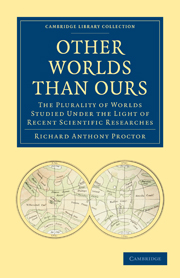 Other Worlds Than Ours
Other Worlds Than Ours Book contents
- Frontmatter
- Preface
- Contents
- ILLUSTRATIONS
- INTRODUCTION
- CHAP. I WHAT THE EARTH TEACHES US
- CHAP. II WHAT WE LEARN FROM THE SUN
- CHAP. III THE INFERIOR PLANETS
- CHAP. IV MARS, THE MINIATURE OF OUR EARTH
- CHAP. V JUPITER, THE GIANT OF THE SOLAR SYSTEM
- CHAP. VI SATURN, THE RINGED WORLD
- CHAP. VII URANUS AND NEPTUNE, THE ARCTIC PLANETS
- CHAP. VIII THE MOON AND OTHER SATELLITES
- CHAP. IX METEORS AND COMETS; THEIR OFFICE IN THE SOLAR SYSTEM
- CHAP. X OTHER SUNS THAN OURS
- CHAP. XI OF MINOR STARS, AND OF THE DISTRIBUTION OF STARS IN SPACE
- CHAP. XII THE NEBULÆ, ARE THEY EXTERNAL GALAXIES?
- CHAP. XIII SUPERVISION AND CONTROL
- Plate section
- Frontmatter
- Preface
- Contents
- ILLUSTRATIONS
- INTRODUCTION
- CHAP. I WHAT THE EARTH TEACHES US
- CHAP. II WHAT WE LEARN FROM THE SUN
- CHAP. III THE INFERIOR PLANETS
- CHAP. IV MARS, THE MINIATURE OF OUR EARTH
- CHAP. V JUPITER, THE GIANT OF THE SOLAR SYSTEM
- CHAP. VI SATURN, THE RINGED WORLD
- CHAP. VII URANUS AND NEPTUNE, THE ARCTIC PLANETS
- CHAP. VIII THE MOON AND OTHER SATELLITES
- CHAP. IX METEORS AND COMETS; THEIR OFFICE IN THE SOLAR SYSTEM
- CHAP. X OTHER SUNS THAN OURS
- CHAP. XI OF MINOR STARS, AND OF THE DISTRIBUTION OF STARS IN SPACE
- CHAP. XII THE NEBULÆ, ARE THEY EXTERNAL GALAXIES?
- CHAP. XIII SUPERVISION AND CONTROL
- Plate section
Summary
Astronomy and Geology owe much of their charm to the fact that they suggest thoughts of other forms of life than those with which we are familiar. Geology teaches us of days when this earth was peopled with strange creatures such as now are not found upon its surface. We turn our thoughts to the epochs when those monsters throve and multiplied, and picture to ourselves the appearance which our earth then presented. Strange forms of vegetation clothe the scene which the mind's eye dwells upon. The air is heavily laden with moisture to nourish the abundant flora; hideous reptiles crawl over their slimy domain, battling with each other or with the denizens of the forest; huge bat-like creatures sweep through the dusky twilight which constituted the primeval day; weird monsters pursue their prey amid the ocean depths: and we forget, as we dwell upon the strange forms which existed in those long past ages, that the scene now presented by the earth is no less wonderful, and that the records of our time may perhaps seem one day as perplexing as we now find those of the geological eras.
Astronomy has a kindred charm. We cannot indeed examine the actual substance of living creatures existing upon other celestial bodies; we cannot even picture to ourselves their appearance or qualities; and only in a few instances can we even form any conception of the conditions under which they live.
- Type
- Chapter
- Information
- Other Worlds Than OursThe Plurality of Worlds Studied under the Light of Recent Scientific Researches, pp. 1 - 6Publisher: Cambridge University PressPrint publication year: 2009First published in: 1870


